
Mule ride to point reveals Canyon beauty
GRAND CANYON VILLAGE, Ariz.— You can feel the sun beaming down on you and every so often you remove another layer of clothing. Your body moves in rhythm with each bump, and there are a lot of bumps.
You hold tight to the reins and peer over the steep ledge of the trail. Rocks jump down the mountainside and you wonder what would happen if you were to fall off. You hold your reins tighter. You continue traveling down the steep incline.
The strong stench of farm animal seems to be seeping into your skin and clothes, but when you look up and see the vast pink and gray walls surrounding the trail, you know you made the right choice by riding a mule down into the Grand Canyon.
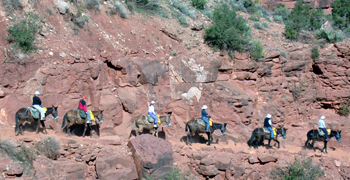 |
Sure-footed mules ride along the Bright Angel Trail on their way to Indian Garden and Plateau Point (Staff photo). |
Mules have been taking tourists into the canyon for 97 years, originally started by Harvey Tours. Before that, mules were used in the canyon to assist miners. Today, guides from Xanterra Parks and Resorts, providing all of the activities from within the canyon, take vacationers to experience the canyon by way of the mule.
On average, Xanterra guides bring 41 people into the canyon daily during the summer months. From November through April, about 27 people ride into the canyon daily on the back of a mule.
The mules weigh between 900 and 1,100 pounds and measure about 15 hands, meaning they are the length of 15 hands from the front hoof to the top of their head. The smallest mules at the canyon are about 13 hands.
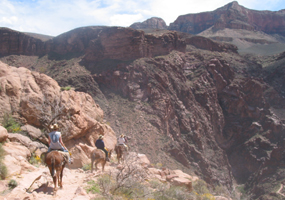 |
Mules move along Bright Angel Trail (Photo by Manuela Picq). |
The mules are trained for one and a half years before going on tours. They come to the canyon between the ages of three and eight, but do not start tours until they are at least four years old. On average, mules live between 35 and 50 years, said trail guide, Marilyn Williams. The oldest mule at the canyon is Poncho, a 27-year-old kid mule.
The training starts by bringing the mules to the top of trail to adapt to the altitude. The guides will ride the mules to find out what their holes are, meaning the fears or obedience problems they may have, which could include a fear of heights or not listening to the rider.
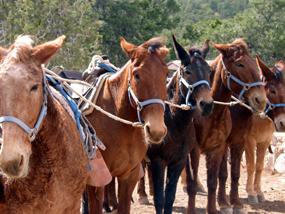 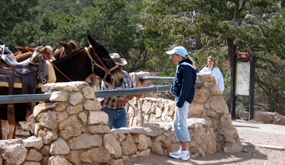 |
Mules await riders and a visitor takes a moment to take a close look (Photos by Tiffany Rainey) |
The trail guides take the mules-in-training down the beginning of the trail to see how they do. When the mules feel safe on the trails and are obedient, they are finished with their training and ready for the tours, said trail guide and cowboy, David Rodriguez.
“The mule I ride in the tours, Tin Man, was afraid of heights when he first came to the canyon. He was actually afraid of everything, so that’s how he got his name. Myself, and the other guides, showed him that everything was going to be all right. He adjusted and became comfortable with the trail and the tours,” said Williams.
Williams, originally from Texas, has worked as a trail guide in the canyon for seven years. Prior to that, she worked with gated horses.
“I’ve always been around livestock and I enjoy the outdoors and being able to work outside. I have a beautiful office, and I get to do what I love most, and that’s riding,” said Williams.
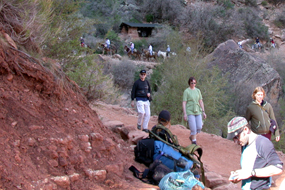 |
Hikers and mule riders often share the narrow Bright Angel Trail on the way to Plateau Point (Staff photo). |
Entertaining guides who love their jobs make the mule rides an enjoyable journey, despite the sore bottoms and thighs of each rider. It’s no wonder you need to reserve your spot six months in advance. This popular activity offers a unique approach to experiencing the canyon, and leaves a lasting impression of the Grand Canyon’s natural beauty with each of its riders.
“What keeps me coming back to the Grand Canyon? Well, the Grand Canyon, of course,” said Don Redfearn of Tucson. “It’s an energizer. Makes you appreciate nature and the earth.”
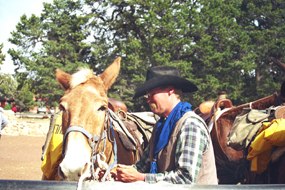 |
A wrangler prepares one of the mules (Photo by Tiffany Rainey). |
The first time Don came to the Grand Canyon was in 1949 on a class trip his senior year of high school.
He was accompanied by his then-girlfriend. The two, now married for more than 50 years, frequently revisit the canyon and, in fact, returned three years ago to celebrate their golden wedding anniversary.
Xanterra offers a few different mule rides to choose from, including a day trip to Plateau Point, where riders depart in the morning and return by 3 p.m. that afternoon; and an overnight trip, where riders travel to the bottom of the canyon and spend a night at Phantom Ranch. In the winter, it is also possible to spend two nights at Phantom Ranch.
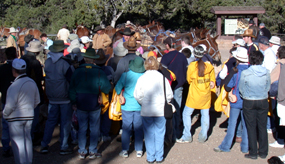 |
Orientation for riders begins early in the morning at head of the Bright Angel Trail (Staff photo). |
“I love the overnight ride to Phantom Ranch the most,” said Rodriguez. “You see such a difference riding down to the river on the Kaibab trail. The trail is much more open and you see more vistas of the canyon. The riders love it also. By then, they’ve gotten used to the mules and can enjoy the scenery a lot more.”
The ride begins at 8 a.m., but you must be there at 7:15 a.m. for orientation, whether you’re participating in the overnight or day trip. The mule rides depart daily from Stone Corral, next to Bright Angel Lodge, and take the Bright Angel Trail into the canyon.
The trail guides will tell you all of the do’s and don’ts, including don’t fall off your mule, before saddling everyone up. The good news? No one has ever died on a Xanterra mule ride.
“We tell the parents [in orientation] that as long as their children are on our mules, they belong to us. Once they’re back on the ground, then they can have their kids back,” said Rodriguez. “Usually children are more adaptable than adults, so it’s more common for the parents to be scared. The majority [of children] are ecstatic and not afraid of the mules or the steep trail.”
If you have some hesitation about riding a mule down a steep trail, they’ll tell you they were able to take a paraplegic into the canyon by mule, and if he can do it, so can you. But if you have a lot of reservation and a strong fear of heights, the trail guides will tell you this ride’s not for you.
“My first thought was that I was not going to survive the ride,” said Hilary Davey of Somerset, England. “But I enjoyed every minute of it. The view from atop a mule is quite the experience.”
Both the overnighters and the day-trippers start off riding together into the canyon, in a single file line, with about one trail guide per 15 riders. Every 20 minutes the trail guides have the mules stop for rest. The mules line up on the trail, in a single file line, facing into the canyon. It is here your heart may jump into your throat if your mule stumbles or wobbles the slightest bit. His front hooves stand on the edge of the trail and his head peers over the cliff.
“If I got scared, I just closed my eyes and kept going,” said Evelyn Redfearn. “When I’m relaxed I can enjoy the view and the weather.”
The tour guides will take you down Jacob’s Ladder, which consists of a steep descent and a lot of switchbacks, where the trail sharply changes direction.
You swear your mule is going to step straight off the trail and plunge thousands of feet into the canyon to its (and your) death. But that doesn’t happen. Each mule gracefully makes the sharp turns and keeps its rider safe.
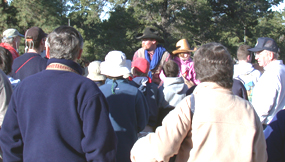 |
Wranglers share tips before the ride begins (Staff photo). |
“My stomach flipped when I first started going down Jacob’s Ladder,” said rider Allison Hanlon, of Los Angeles. “After a couple switch-backs though, I was okay. I thought my mule was going to walk right off the edge of the trail and when I got that notion out my head, I relaxed and began to appreciate the views of the canyon and the thrill of Jacob’s Ladder.”
Indian Garden is the four and a half mile marker, where all riders get to dismount for the bathroom and water. This is where the overnight riders split from the rest of the pack, taking a different trail to Phantom Ranch. The day-trippers continue on the Bright Angel Trail for one and a half more miles to Plateau Point, where they will dismount for rest, lunch and pictures.
“The environment at Indian Gardens is very colorful. There are a lot of cactus and flowers. It’s a great place for a break because of the shade from all of the trees, and of course because there’s water and bathrooms,” said hiker Molly Cooney of Boston.
The six-mile trip, descending 3,200 feet, to Plateau Point takes a little over three hours, and riders can enjoy sitting at the edge of the plateau and eating a hearty boxed lunch provided by Xanterra. The Colorado River rushes 1,320 feet below you as you dangle your now sore limbs over the rocks.
“Plateau Point offers a brilliant view from within the Canyon. Something you can’t get from the viewpoints on the rim,” said fellow Grand Canyon traveler Mark Sandeen of Oakton, VA.
After observing the river at the plateau for a half hour, riders mount their mules and begin their ascent back to Bright Angel Lodge and Stone Corral.
“It was brilliant coming up. I’d rather come up [the canyon] first,” said Davey. “The layers and formations of rock are fantastic. That’s something I’ll never forget.”
When returning to Stone Corral, each rider dismounts their mule and receives a certificate declaring them a member of the “Order of the Master Mule Skinners of the Grand Canyon Trails.” Sore and stiff bodies slowly wobble over to the trail guides to accept their certificates.
“Being sore was definitely worth it. The Grand Canyon means something to me now because I was able to experience it from within, and by mule,” said Davey. “Before, it was just something I’d seen in the distance from the view points along the rim.”
When traveling to the Grand Canyon, mule rides are always an activity to consider. The experience will last a lifetime, and even if you’re an avid hiker, it’s something to check out, as the view is always different from atop a mule.
“Anybody that has an ounce of adventure in their soul should definitely put the mule ride on their agenda,” said the Redfearns, who have experienced both the overnight and day-trip. “Relax, have faith in the mules and what the guides tell you. Enjoy the experience and the view.”
If You Go
If you want to ride, you must:
• not weigh more than 200 pounds, fully clothed.
• be at least four feet, seven inches tall
• speak and understand fluent English
• be in good physical condition
• not be pregnant
• not be afraid of heights or large animals
What you have to wear to ride a mule:
• Between April and October, each rider must have a wide-brimmed hat
• Long-sleeved shirt and long pants (no shorts or capri pants)
• Solid, close-toed shoes
• It is recommended to dress in layers. The ride will start off cool at that top and get warmer the further into the canyon you go.
General Information, Costs:
For reservations, contact 888-29-PARKS or http://www.grandcanyonlodges.com
DVDs and videotapes are available for purchase to prepare you for the mule ride by visiting the website or by writing to: Xanterra Mule Trip Videos, P.O. Box 97, Grand Canyon, Ariz. 86023.
The day ride to Plateau Point (includes lunch): $119.25 per person.
The overnight ride to Phantom Ranch (includes all meals and accommodations): $322.50 for one person; $575 for two people; $263 for an additional person

Comments are Closed